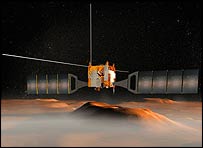In the previous attempt, one of the components did not lock into place

European Space Agency engineers have successfully deployed the first of three antennas on the Mars Express spacecraft.
The antennas are part of the Mars device, which will look below the surface of Mars and try to find the huge water reservoirs there.
The antenna, which is 20 meters long and was folded, unfolded about a week ago but was not completely locked in place. Only when the spacecraft rotated around itself to heat its cold parts with sunlight could the process be completed. The continuation of the retirement of the other antennas will be completed within a few weeks, but not before the engineers learn the lessons from the retirement of the first and main antenna of the spacecraft. There is an identical 20-meter long antenna that will point in the opposite direction to that to which the first antenna will point, as well as another seven-meter long antenna.
The project itself is over a year behind schedule due to fear that the deployment of the antennas will damage the other instruments on the spacecraft. The successful unlocking of the antenna's 13 parts is encouraging to flight controllers at the European Space Agency's operations center in Darmstadt, Germany, because they can unlock the remaining components of Marsis. The scientists are already waiting for the first results of the device's activity.
The antennas will transmit low frequency radio waves towards the planet. These signals will be returned from all the terrain routes they will meet, up to a depth of 5 km below the surface of the ground.
The scientists believe that beneath the surface there is a huge reservoir of water preserved from wetter times. Some of the scientists also believe that these reservoirs can serve as a habitat for bacteria.
For news at the BBC
Delay in opening the Mars Express spacecraft's radar
10/5/2005
The opening of the radar antenna on the Mars Express spacecraft, which has already been delayed for over a year, will wait a little longer until it is fully completed. Flight controllers found problems opening one of the antenna arms last Wednesday. Officials at the European Space Agency said that 12 of the 13 components that make up the first arm were successfully installed, but component #10 was not fully locked into place. The Marsis radar has three arms that were designed to extend out of the spacecraft like a Nahum Takum doll.
A spokesman for the space agency said that the malfunction does not threaten the entire mission. The flight controllers were supposed to release the second beam on Sunday but following the discovery of the malfunction in the first entente, it was decided to stop the process. These days, meetings are being held to determine the rules of the disclosure on the implementation of the second fund.
"This is mainly a precautionary measure and nothing else. It takes a lot of time to decide whether to continue and we want to be careful," said the spokesman. "We are checking whether this component was close to complete locking or is far from it."
The arm, which is 20 meters long, forms half of the main antenna of Marsis (Mars Advanced Radar for Subsurface and Ionosphere Sounding).
The main antenna will launch the radio waves towards the surface of the red planet. Some of them will even penetrate below the surface and provide data on the composition of hidden layers of rocks and possibly water.
The radar may also allow scientists to identify underground reservoirs up to a depth of 5 km, where the water can serve as a habitat for microscopic life.
As mentioned, the removal of the antennas was delayed for over a year due to the fear that these arms would collapse back and damage the spacecraft which could be damaged by this. The experiment can also function without the third 7-meter long antenna (Monopole, its name), but the component will help researchers confirm whether the returned radio waves actually reach the ground or are simply bounced back from a greater distance above the ground.
